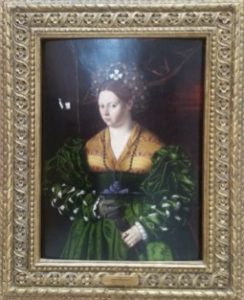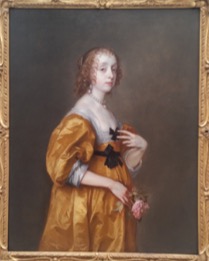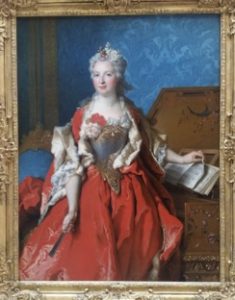Renaissance Portraiture from the Timken

The Portrait of a Lady in a Green Dress painted by Bartolomeo Veneto sometime between 1502-1531 shows the wide, high-waisted voluminous gown complete with contrasting colors and slashed sleeves which expose the blackwork embroidered chemise or smock underneath that are iconic of early 16th century fashion particularly with Italian attire, although This is a transition from the silhouette of the Medieval period, which favored long vertical lines. The addition of fabric in the 16th century could have been due to general economic improvements and a decrease in overall temperatures of the time. The folded over neckline, glittering gold thread which seems apparent on the yellow kirtle, a blouse worn over the smock but underneath the gown, (Bartolomeo Veneto, Portrait of a Lady in a Green Dress, 1530, http://www.timkenmuseum.org/collection/italian/portrait-lady-green-dress)as well as the pomegranate and artichoke motifs are also iconic during the early 16th century. These motifs and decorations are removed from the ecclesiastical ornamentation of periods previous. These costume details and ornamentations, as well as the human hair piece that is decorated with blue and gold ribbon pieces, separate her from other nobility of the time and certainly from those less wealthy.

Mary Villiers, Lady Herbert of Shurland, was painted by long time acquaintance and artist Anthony Van Dyck (Anthony Van Dyck, Mary Villiers, Lady Herbert of Shurland, ca. 1636, http://www.timkenmuseum.org/collection/dutchflemish/mary-villiers-lady-herbert-shurland). The elbow length sleeves stay with the general fashion of Europe during 17th century but neckline strays away from desirable fashion trends seen in other areas like France, Spain and Italy and instead the square neckline stays true to Scandic costume. The smock is not displayed as was fashionable in more “liberal” and fashion conscious France but the chest is exposed although the overall silhouette itself is highly distorted through corseting. Even though the square neckline was distinct for places like the Netherlands, however, heavily ornamented costuming were slowly replaced by solid colored satins and simple bows which the Netherlands followed. This type of “nightgown” was very popular in the Netherlands and other Scandic countries so much so that is was called the Dutch round gown. During the 17th and 18th centuries and waistlines will rise and drop often.

This is a portrait of Portrait of Marguerite de Sève, painted by the famous portraitist Nicolas de Largilliérre sometime between 1656-1746. The 17th century was met with rapid change in fashion and even greater variety between regions which influenced each other’s dress. We see a return to the long vertical bodice that was apparent in the Medieval period, contrasting the wide, high-waisted silhouette of the previous two portraits, as well as a period of brief opulence as the costs of textiles decreased even before the industrial revolution. Since Marguerite de Sève still bears a bejeweled military inspired bodice or stomacher tells me that this portrait would have most likely been commissioned more in the mid 17th century rather than later in the time period when this painting was thought to have been painted. Although her bodice appears to be constructed of metal, which it very well may have been, according to the Timken museum site, it says that it may have been silk mounted on buckram giving it the stiff sheen appearance (Nicolas de Largilliérre,
Portrait of Marguerite de Sève, Wife of Barthélemy-Jean-Claude Pupil, 1729, http://www.timkenmuseum.org/collection/french/portrait). Two differences between French fashion and fashion in other regions are apparent in this portrait: emphasis on the rounded shoulder silhouette created by a corseted body, broad neckline and dropped shoulder, a bit hidden here by her cloak, as well as the display of the chemise or smock, undergarment. The color red, velvet fabric and fur lined garments were also of high fashion during this time. These details are reflected in the portrait since the French were highly fashionable and kept up with and set fashion trends as well. Other regions, such as in Spain and Holland remained more modest throughout the century.
*I apologize for the blurred images. The photos I took are clear but when I cropped them both in Word and with WordPresses photo editing software that’s how they turned out, however, the portraits can be seen clearly in the links I have provided!
Beautiful! I am so pleased you dealt with why – we have much detail on the fashions, but we needed to discuss how these fashions reflect the history of their day, as you did by noting the cost of textiles, economic improvements, and the definitions of liberality.